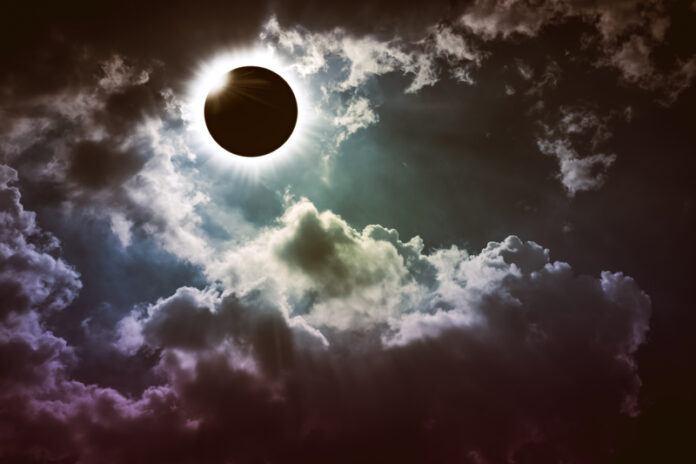It was 2:45 in the afternoon when I turned my computer off after tracking the total solar eclipse from the shadow’s landfall in Mazatlan, Mexico. It was time to walk downstairs with my pinhole cereal box camera I had made and a colander in tow to the square directly in front of our apartment in Bronte, Ontario. My commute to see the eclipse was no more than 100 metres because Bronte was directly on the path of totality. We probably could have watched it from our balcony, but with others gathered around us, it was even more exciting.
Our neighbour had seen us down below and came to join in the spectacle bringing along a spare pair of eclipse glasses which my wife and I shared. It had been cloudy all morning with interspersed moments when it looked like the Sun would peek out followed by others that seemed to threaten rain. A little after 3:00, a sliver of blue showed. It was a break in the clouds and there it was, the ever-shrinking, crescent-shaped Sun.
As a young boy, I have experienced many lunar eclipses, setting up my telescopes in our backyard, or trekking to the Dunlop Observatory north of Toronto to watch the Earth’s shadow traverse the Moon. I also remember a partial eclipse with my telescopes in the backyard projecting images of the crescent Sun onto white bristleboard. The latter had been my sole experience with a solar eclipse.
This was very different. As the Sun shrank to a sliver, the excitement in the crowd of young and old surrounding me was palpable. My wife turned to me and said, “Boy, this is cool.” And it was.
Totality came suddenly at 3:19. The Sun winked out and a burst of light surrounded an inky-black circle. The eclipse glasses came off, and for what seemed like a minute, although I was told it was less, the light show commenced and it was spectacular.
We were viewing the corona, the atmosphere of our star with its hairlike plasma threads visible against a dark central disk. I caught a brief glimpse of the planet Venus in dusk-like light conditions. I missed seeing Jupiter which I was told was visible. Small flaring pink protuberances jetted the Sun’s surface. They were visible to the naked eye. These were plasma erupting into the surrounding space.
The Sun’s winking out created a weird period of darkness. The daylight dimmed to night. The air suddenly cooled. Street lights came on. We were not just looking at the vanished star but also at the creeping shadow of darkness progressing visibly from southwest to northeast. Then it was over as the diamond ring phenomenon indicated the Sun’s reemergence from behind the Moon’s shadow. In a few minutes, we were back in the everyday. The moments of totality were over but the memory of it will stay with me forever.
We are so fortunate to be living on a planet with a Moon that at this time is perfectly positioned to create a total eclipse of our home star. This doesn’t happen on Mars because its two moons are far too small to create totality when they cross the Sun’s path.
No other planets in our Solar System have the right mathematics to create this phenomenon. The Moon is 400 times smaller than the Sun and 400 times closer to Earth. The math is elegant right now and will be for a considerable amount of time in the future. How far? As the Moon continues to slowly spiral outward from Earth, 600 million years in the future there will no longer be total eclipses of the Sun.
















